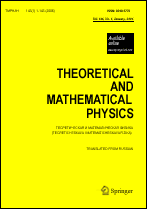|
This article is cited in 11 scientific papers (total in 11 papers)
Topological Correlations in Trivial Knots: New Arguments in Favor of the Representation of a Crumpled Polymer Globule
O. A. Vasil'eva, S. K. Nechaevab
a L. D. Landau Institute for Theoretical Physics, Russian Academy of Sciences
b Paris-Sud University 11
Abstract:
We prove the representation of a fractal crumpled structure of a strongly collapsed unknotted polymer chain. In this representation, topological considerations result in the chain developing a densely packed system of folds, which are mutually segregated at all scales. We investigate topological correlations in randomly generated knots on rectangular lattices (strips) of fixed widths. We find the probability of the spontaneous formation of a trivial knot and the probability that each finite part of a trivial knot becomes a trivial knot itself after joining its ends in a natural way. The complexity of a knot is characterized by the highest degree of the Jones–Kauffman polynomial topological invariant. We show that the knot complexity is proportional to the strip length in the case of long strips. Simultaneously, the typical complexity of a “quasi-knot”, which is a part of a trivial knot, is substantially less. Our analysis shows that the latter complexity is proportional to the square root of the strip length. The results obtained clearly indicate that the topological state of any part of a trivial knot densely filling the lattice is also close to the trivial state.
Keywords:
knots, polymers, topological invariants, Brownian bridge, non-Euclidean geometry.
Received: 14.02.2002
Citation:
O. A. Vasil'ev, S. K. Nechaev, “Topological Correlations in Trivial Knots: New Arguments in Favor of the Representation of a Crumpled Polymer Globule”, TMF, 134:2 (2003), 164–184; Theoret. and Math. Phys., 134:2 (2003), 142–159
Linking options:
https://www.mathnet.ru/eng/tmf155https://doi.org/10.4213/tmf155 https://www.mathnet.ru/eng/tmf/v134/i2/p164
|


| Statistics & downloads: |
| Abstract page: | 574 | | Full-text PDF : | 246 | | References: | 104 | | First page: | 1 |
|




 Contact us:
Contact us: Terms of Use
Terms of Use
 Registration to the website
Registration to the website Logotypes
Logotypes








 Citation in format
Citation in format 
